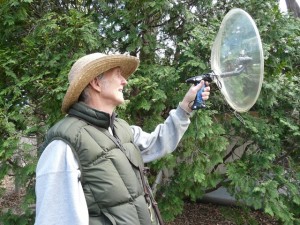 Sound is an important way to connect with nature. If you start learning the calls of birds and frogs heard in the spring, your love for nature will skyrocket. I used a parabolic dish to record the sounds heard below. To record a sound, I point the dish directly at the bird/frog that is singing, it amplifies the sound and is received by my recorder. I took all of the photos in this post over the past few years.
Sound is an important way to connect with nature. If you start learning the calls of birds and frogs heard in the spring, your love for nature will skyrocket. I used a parabolic dish to record the sounds heard below. To record a sound, I point the dish directly at the bird/frog that is singing, it amplifies the sound and is received by my recorder. I took all of the photos in this post over the past few years.
Woodland
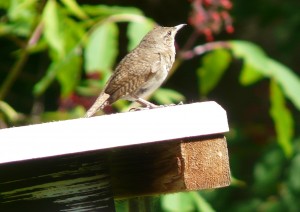 House Wren– House wrens started calling in late May. Last year one pair took over a chickadee cavity nest and filled the nest with sticks. In mid June the wrens will be call all day long.
House Wren– House wrens started calling in late May. Last year one pair took over a chickadee cavity nest and filled the nest with sticks. In mid June the wrens will be call all day long.
Listen:
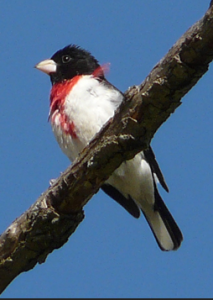 Rose Breasted Grosbeak– Grosbeaks begin calling in the first week of May. It is one of my favorite songs to hear and look forward to the grosbeak’s return each year. Many birdwatchers say it sounds like a “hurried-up robin call”, but to me, it is like hearing heaven on earth.
Rose Breasted Grosbeak– Grosbeaks begin calling in the first week of May. It is one of my favorite songs to hear and look forward to the grosbeak’s return each year. Many birdwatchers say it sounds like a “hurried-up robin call”, but to me, it is like hearing heaven on earth.
Listen:
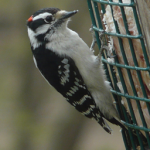 Downy Woodpecker – In this segment you will hear a downy woodpecker drumming on a dead tree. This is a woodpecker’s way of announcing their breeding territory.
Downy Woodpecker – In this segment you will hear a downy woodpecker drumming on a dead tree. This is a woodpecker’s way of announcing their breeding territory.
Listen:
Cardinal – In this recording, there are two cardinals calling. One in the foreground and one in the background.
Listen:
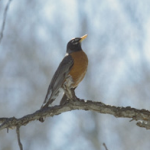 Robin – The fluted call of the robin is a beautiful and common sound in our neighborhoods. I heard the first male robin singing this year (2015) in mid March. By mid April start calling at 6 am.
Robin – The fluted call of the robin is a beautiful and common sound in our neighborhoods. I heard the first male robin singing this year (2015) in mid March. By mid April start calling at 6 am.
Listen:
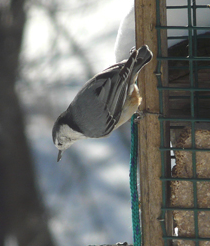
White-breasted nuthatch – The spring mating call of the white breasted nuthatch is another common forest sound.
Listen:
Listen:
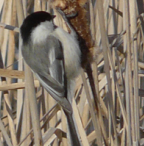 Chickadee– The “feebee” call of the chickadee is one of the most common sounds heard in the early spring. It is the chickadee territorial call that is usually only heard in the spring.
Chickadee– The “feebee” call of the chickadee is one of the most common sounds heard in the early spring. It is the chickadee territorial call that is usually only heard in the spring.
Listen:
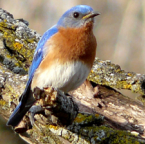 Eastern bluebird – The call of the bluebird is very unique and beautiful call.
Eastern bluebird – The call of the bluebird is very unique and beautiful call.
Listen:
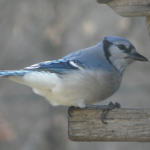
Blue Jay – The blue jay is commonly heard year round, making its “jay, jay, jay” call. Also, in this recording you will hear the unusual “pumphandle” call of the blue jay.
Listen:
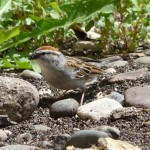 Chipping Sparrow – The first chipping sparrow started calling this week in my neighborhood (April 16th). It likes to sing near the road and then fly down to the road to eat the seeds/flowers of box elder.
Chipping Sparrow – The first chipping sparrow started calling this week in my neighborhood (April 16th). It likes to sing near the road and then fly down to the road to eat the seeds/flowers of box elder.
Listen:
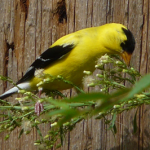 Goldfinch – The goldfinch will change from their drab winter plumage to their beautiful summer colors. They have started to sing frequently (April 16, 2015)
Goldfinch – The goldfinch will change from their drab winter plumage to their beautiful summer colors. They have started to sing frequently (April 16, 2015)
Listen:
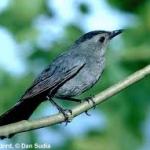
Catbird – The first catbird may be callingfrom the bushes in the first week of May. Catbirds sing continuously and the call changes. They are sometimes referred to as “Minnesota mockingbirds” because catbirds and mockingbirds have similar calls. Lastly, they make a meowing-like call that sounds like a cat in the bushes.
Wetland
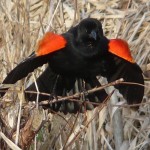 Red-wing blackbird – The call of red-wing blackbird is often called “The voice of the marsh”. Its “okalee” call can be heard throughout the wetlands.
Red-wing blackbird – The call of red-wing blackbird is often called “The voice of the marsh”. Its “okalee” call can be heard throughout the wetlands.
Listen:
Wood duck – The call of the wood duck is common around small ponds.
Listen:
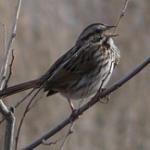 Song Sparrow– The call of the song sparrow is another common wetland song.
Song Sparrow– The call of the song sparrow is another common wetland song.
Listen:
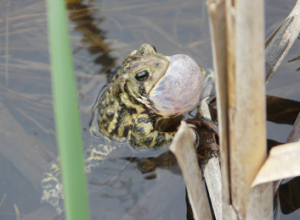 American Toad – One of the dominant night sounds in May is the calling of the toads. I often have my window open, so I can be lulled to sleep by the trilling of the toads.
American Toad – One of the dominant night sounds in May is the calling of the toads. I often have my window open, so I can be lulled to sleep by the trilling of the toads.
Listen:
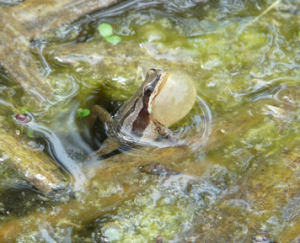 Chorus Frogs – The chorus frog is about 1/2 inch in size. The sound can be deafening when they are calling. However, they are very difficult to find if you are searching for them. Chorus frogs have also been called “cricket frogs” because their call resembles crickets.
Chorus Frogs – The chorus frog is about 1/2 inch in size. The sound can be deafening when they are calling. However, they are very difficult to find if you are searching for them. Chorus frogs have also been called “cricket frogs” because their call resembles crickets.
Listen:
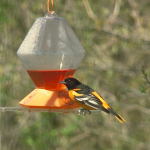 Northern Oriole – May 1st is “Oriole Day” in Minnesota. Orioles migrate all way to Central America, so it takes a while for them to return. They are one of my favorite spring calls, and often are found where there are cottonwood trees.
Northern Oriole – May 1st is “Oriole Day” in Minnesota. Orioles migrate all way to Central America, so it takes a while for them to return. They are one of my favorite spring calls, and often are found where there are cottonwood trees.
Listen:

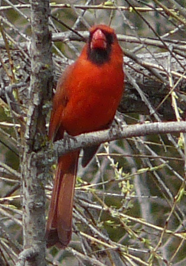
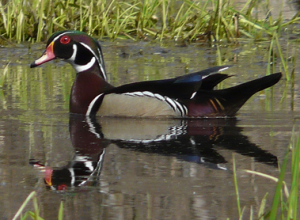



Wow, this is amazing. this post really transports me back to spring in MN. Everything is warming up and coming out of their shells!
What a wonderful page of sounds! While walking in the marsh behind The Marsh, I heard a chuckling sound coming from the dried reeds two days in a row, same place. I tried to make it into frog sounds, but it wasn’t quite. My best guess was some waterfowl. Any thoughts?
The first Baltimore Oriole’s were spotted along East side of the Mississippi in Fridley the weekend of May 9th – 11. I put my feeder out for them and they started coming to my feeder on May 9th 2014. Such pretty birds!
Thank you so much for the beautiful pictures along with the amazing sounds! I hope to use your page with my second graders this coming year as we discover and explore nature we can find in the city.
Natasha: In September, I teach a grasshopper unit to kids that is very fun. If you have a copy of my book, Nature Seeker Workbook (pages 132-37). If not, send me your email address (larrywade16@gmail.com) and I’ll send you a PDf of the unit. Larry